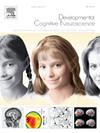使用近红外光谱研究儿童早期和成年早期前额叶皮层的内在功能连接和执行功能
IF 4.9
2区 医学
Q1 NEUROSCIENCES
引用次数: 0
摘要
执行功能(EF)对目标导向行为至关重要,并预测整体幸福感、学业和人际关系的成功。自然主义范式中的内在(即非诱发的)静息状态功能连接(rsFC)提供了对EF背后的神经机制的深入了解。然而,很少有研究利用功能性近红外光谱(fNIRS)探索EF-rsFC在不同年龄组之间的关联。本横断面研究利用近红外光谱(fNIRS)验证了一种自然观看范式(insapes),并研究了4-5岁儿童和18-22岁年轻人前额叶皮层(PFC)的rsFC与EF之间的联系。在一个平衡的受试者设计中,成年人被呈现了两个rsFC范式:传统的静态十字准星和insapes。表征相似性分析显示,十字准星和内景条件下的rsFC模式非常相似,且两者都与EF (Stroop性能)相关。儿童使用insapes来评估rsFC, fNIRS显示出较高的依从性。重要的是,用insapes评估儿童rsFC与EF (Stroop-like Day-Night Task performance)相关。年龄相关的差异显示了PFC在发展过程中增强的内在功能联系。本研究使用儿童友好、无创的光学神经成像和公开可用的rsFC范式来阐明PFC在EF发展中的作用,为研究EF的发展轨迹和神经基础提供实用的方法方法。本文章由计算机程序翻译,如有差异,请以英文原文为准。
Prefrontal cortex intrinsic functional connectivity and executive function in early childhood and early adulthood using fNIRS
Executive function (EF) is crucial for goal-directed behavior and predicts overall wellbeing, academic and interpersonal success. Intrinsic (i.e., non-evoked) resting state functional connectivity (rsFC) during naturalistic paradigms offers insight into neural mechanisms underlying EF. However, few studies have explored EF-rsFC associations using functional near-infrared spectroscopy (fNIRS) across age groups. This cross-sectional study validates a naturalistic viewing paradigm (Inscapes) using fNIRS and examines the link between rsFC in the prefrontal cortex (PFC) and EF in children ages 4–5 and in young adults ages 18–22. Adults were presented with two rsFC paradigms in a counterbalanced within-subjects design: a traditional static crosshair and Inscapes. Representational similarity analysis revealed robustly similar rsFC patterns between the crosshair and Inscapes conditions, and both were associated with EF (Stroop performance). Children were presented with Inscapes to assess rsFC, and exhibited high compliance using fNIRS. Importantly, rsFC assessed with Inscapes in children was associated with EF (Stroop-like Day-Night Task performance). Age-related differences showed intrinsic functional connections within the PFC strengthening over development. This study uses child-friendly, noninvasive optical neuroimaging and a publicly available rsFC paradigm to elucidate the role of the PFC in EF development, illuminating practical methodological approaches to study the developmental trajectory and neural underpinnings of EF.
求助全文
通过发布文献求助,成功后即可免费获取论文全文。
去求助
来源期刊

Developmental Cognitive Neuroscience
NEUROSCIENCES-
CiteScore
7.60
自引率
10.60%
发文量
124
审稿时长
6-12 weeks
期刊介绍:
The journal publishes theoretical and research papers on cognitive brain development, from infancy through childhood and adolescence and into adulthood. It covers neurocognitive development and neurocognitive processing in both typical and atypical development, including social and affective aspects. Appropriate methodologies for the journal include, but are not limited to, functional neuroimaging (fMRI and MEG), electrophysiology (EEG and ERP), NIRS and transcranial magnetic stimulation, as well as other basic neuroscience approaches using cellular and animal models that directly address cognitive brain development, patient studies, case studies, post-mortem studies and pharmacological studies.
 求助内容:
求助内容: 应助结果提醒方式:
应助结果提醒方式:


